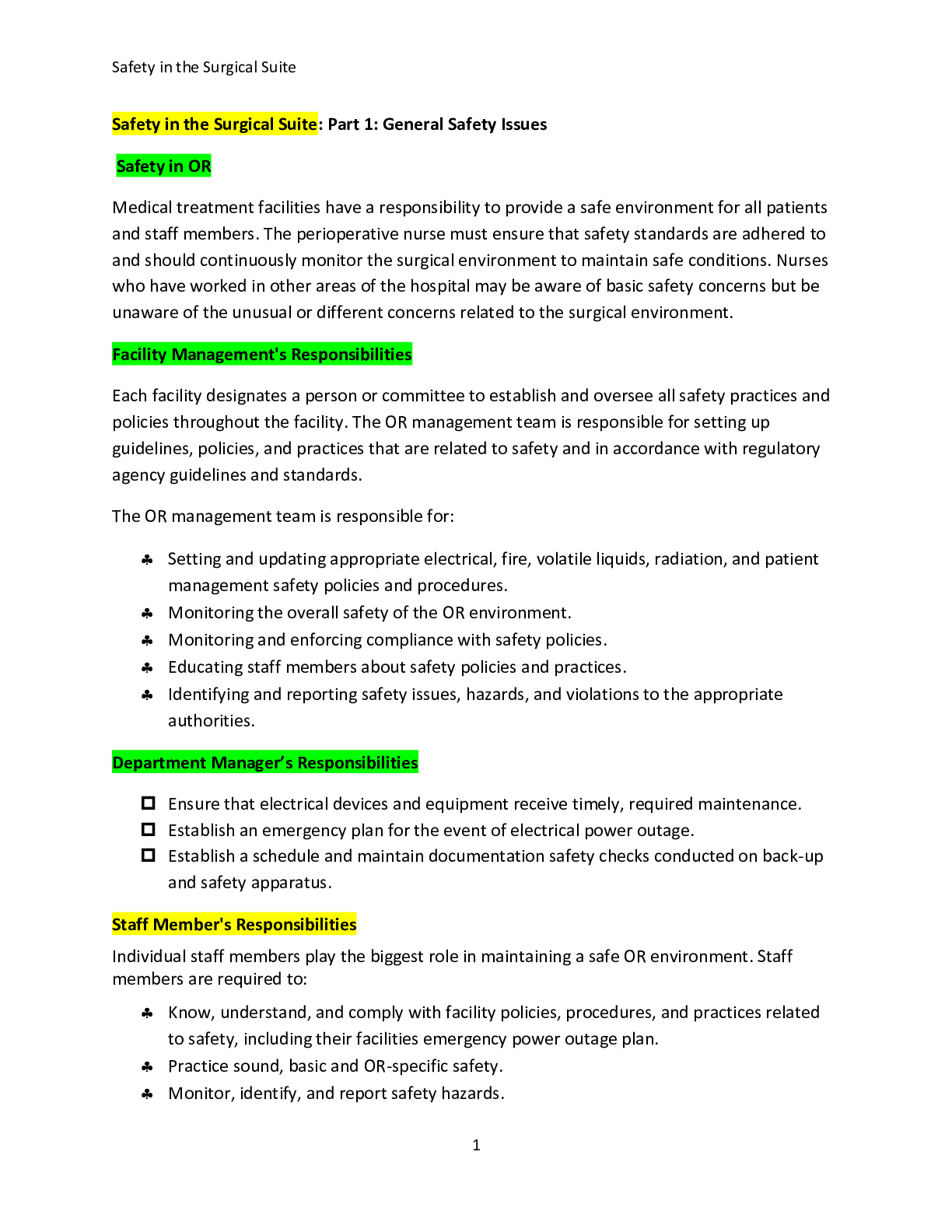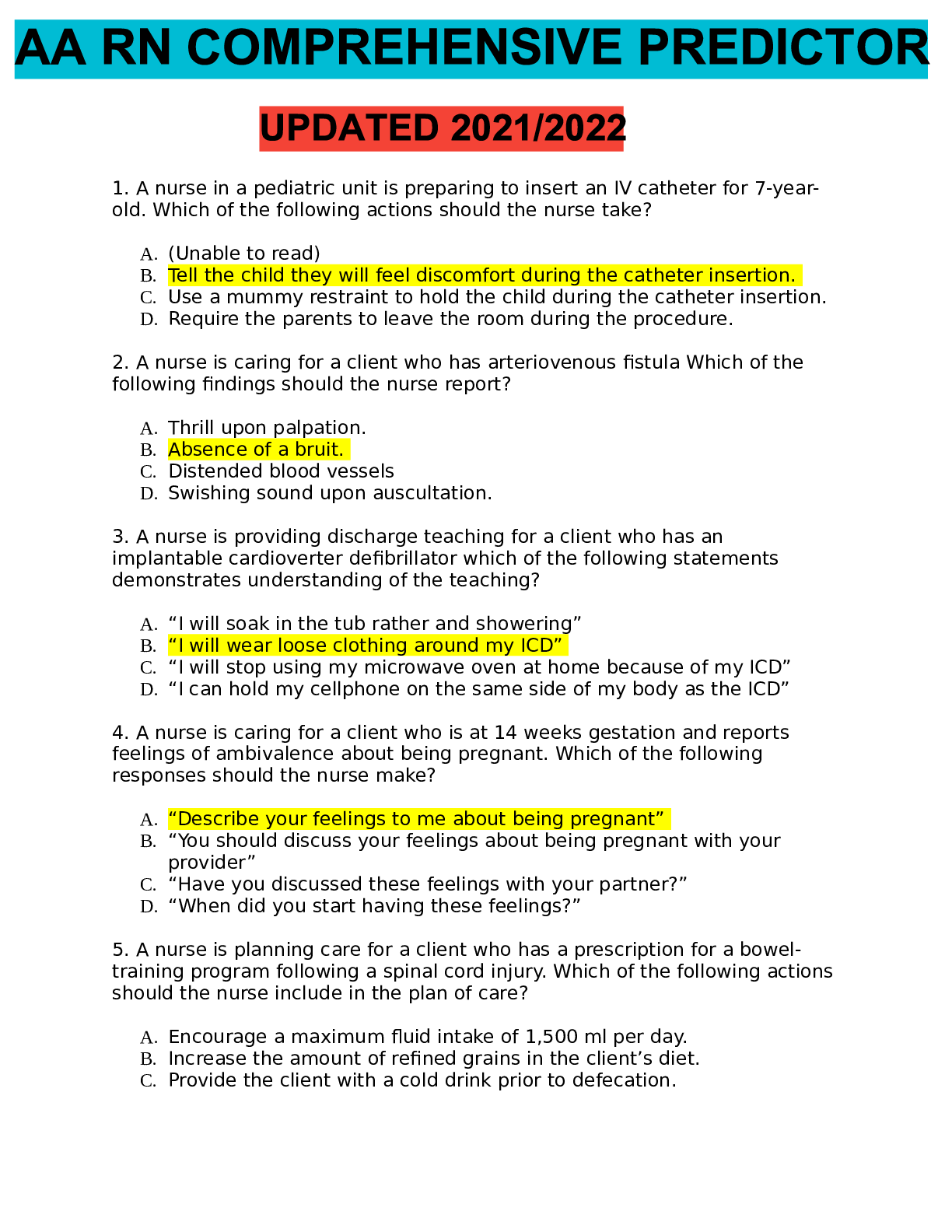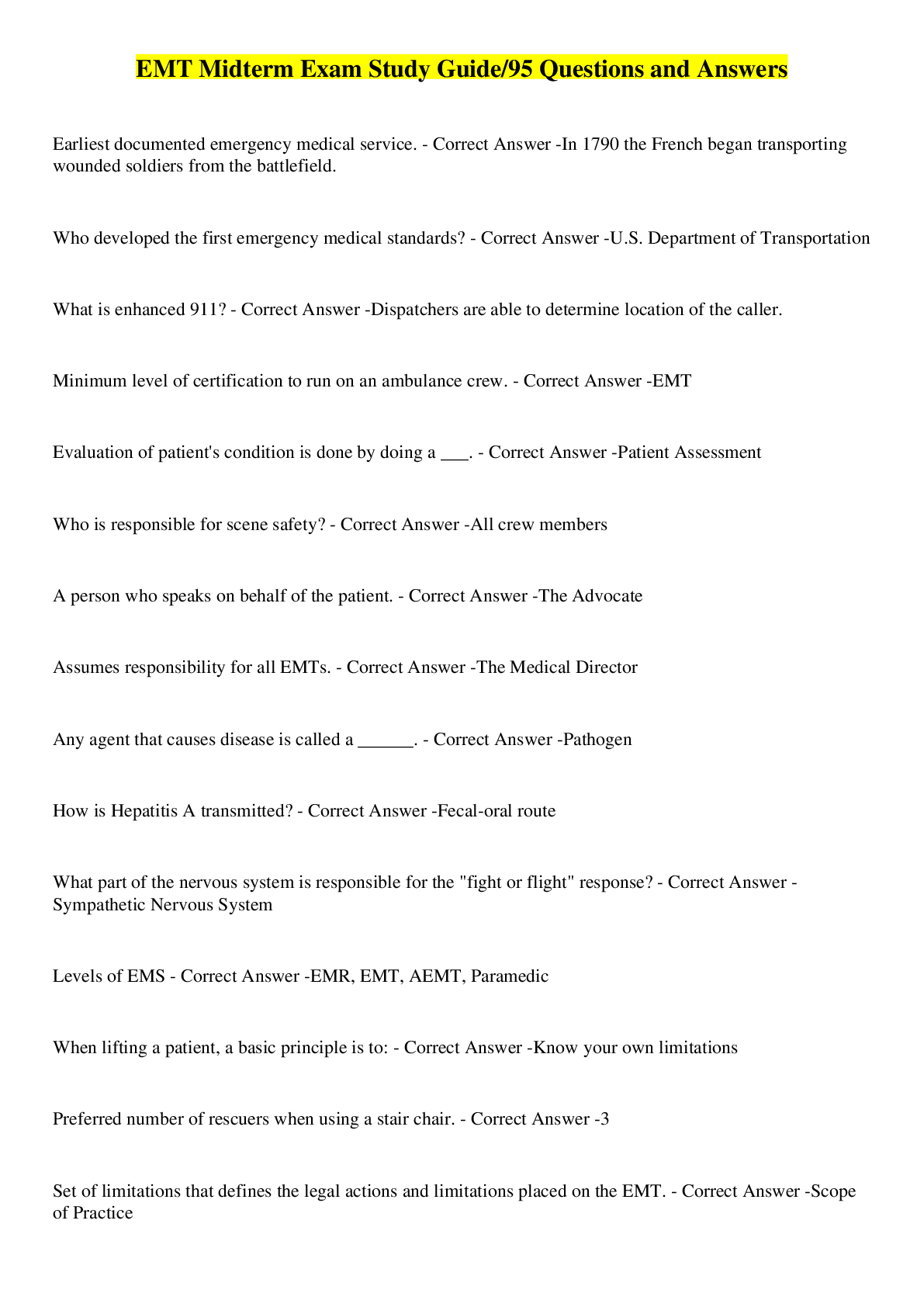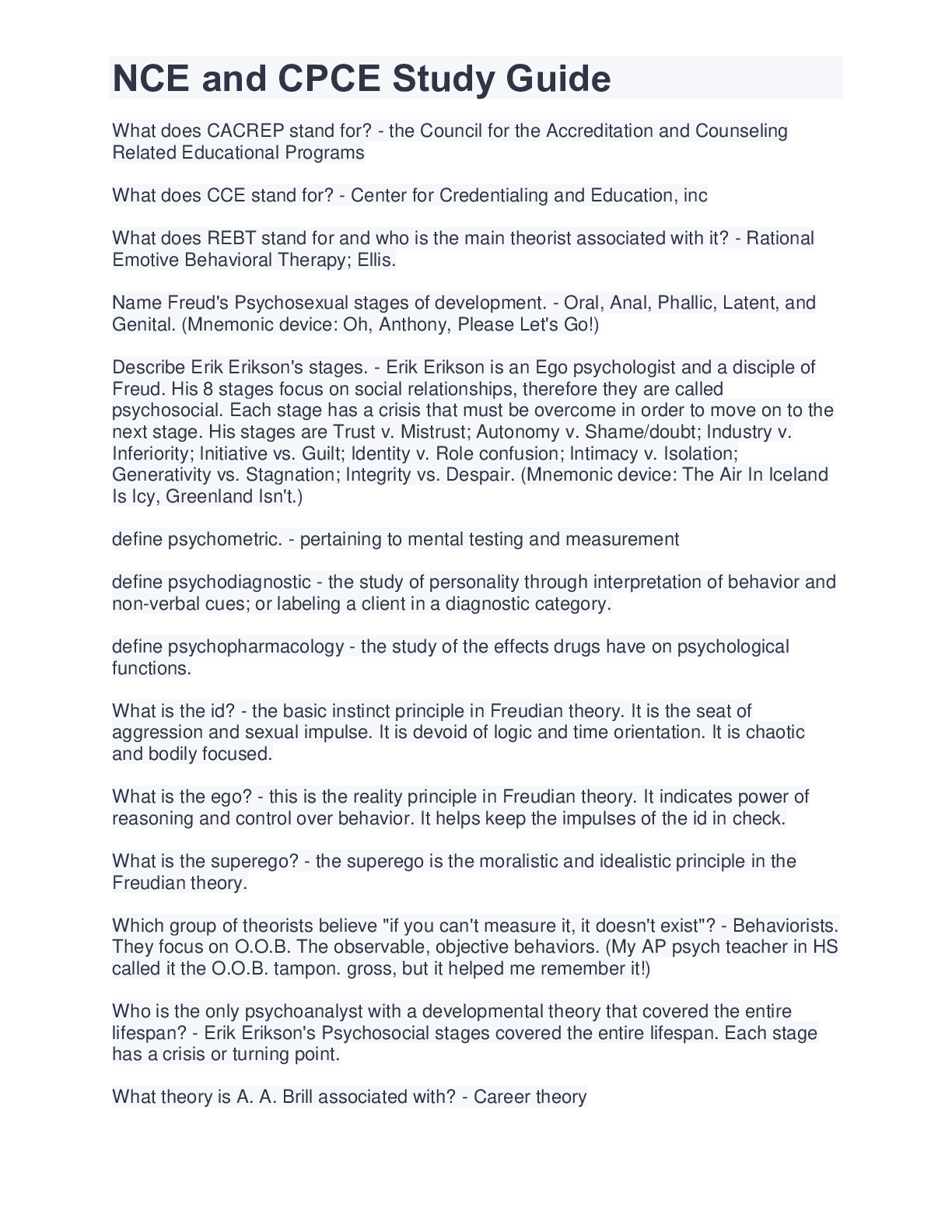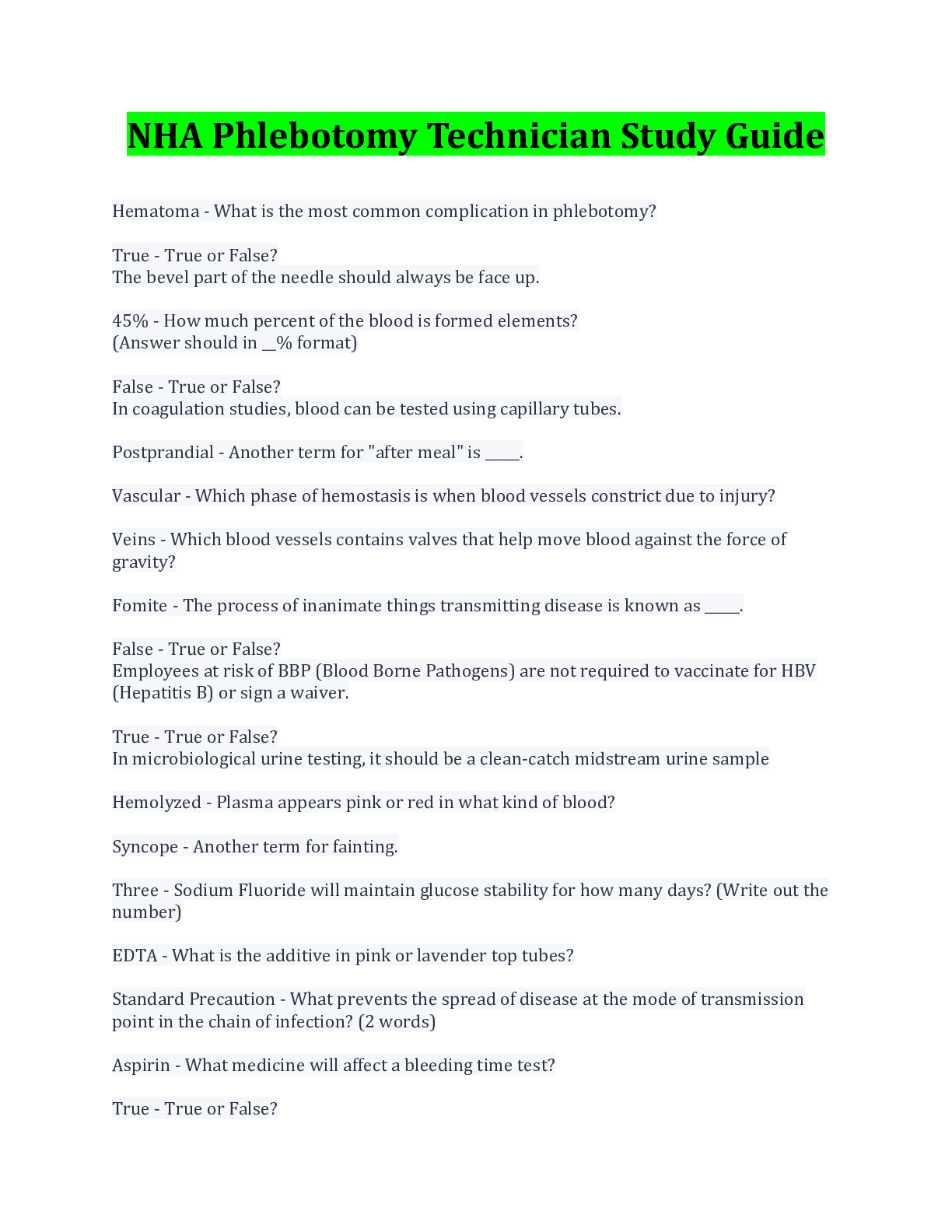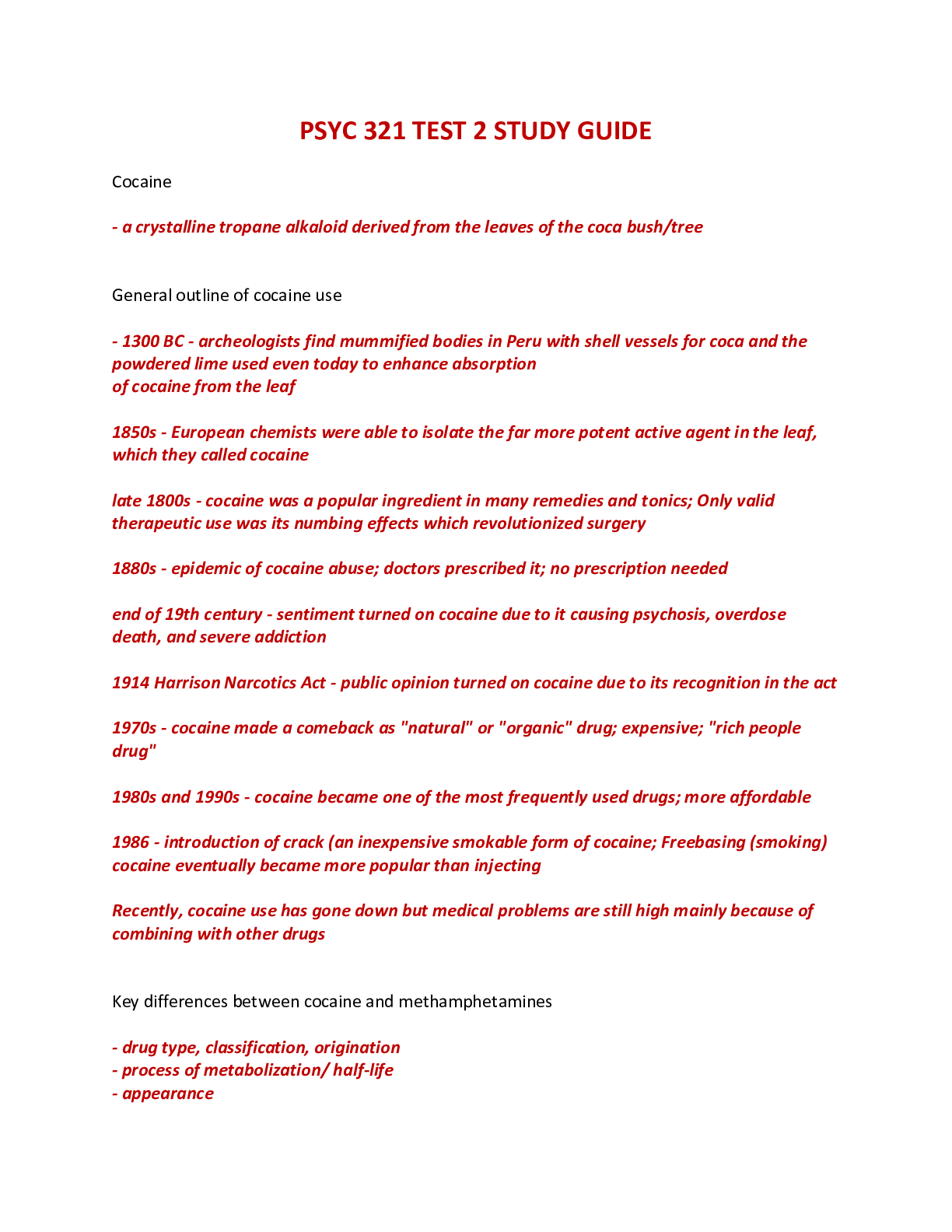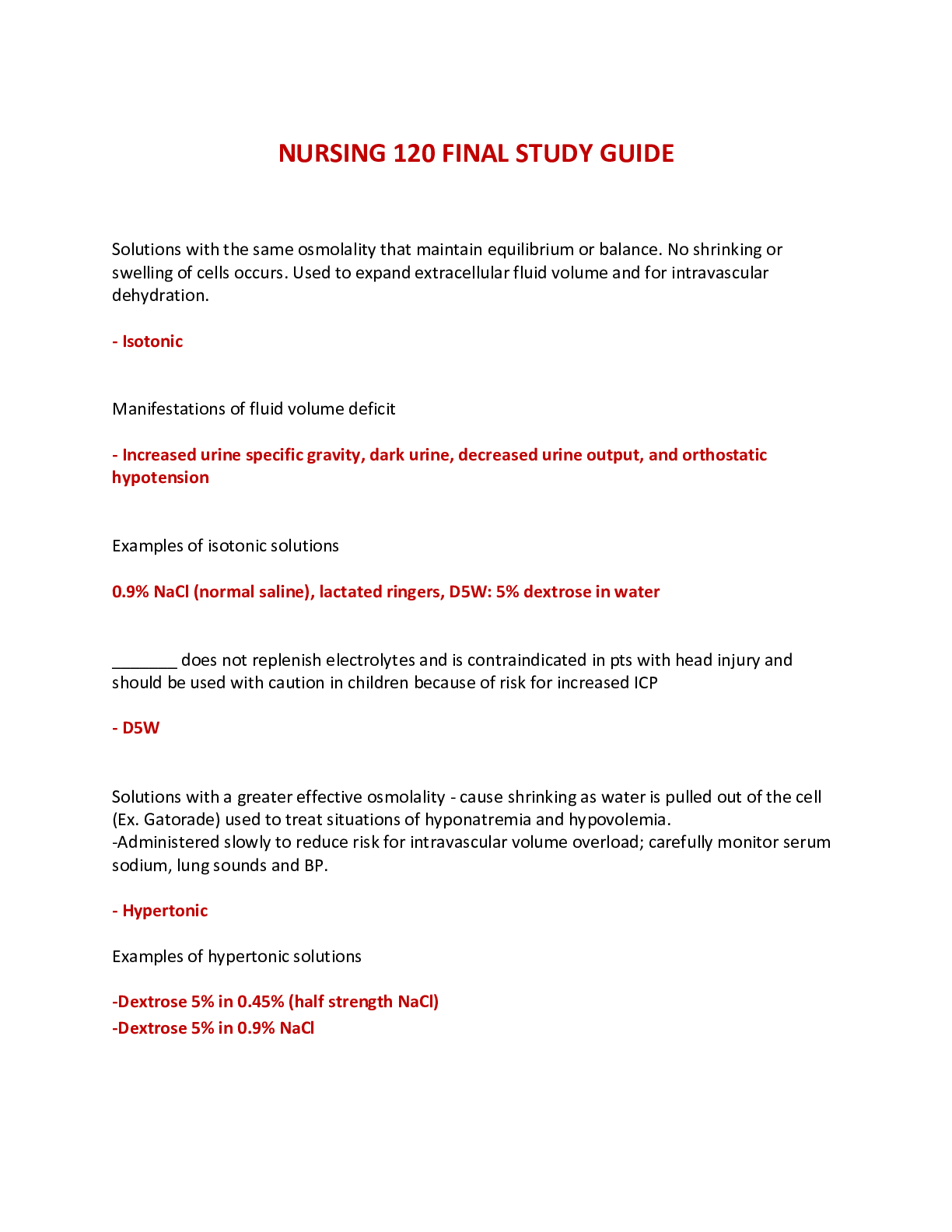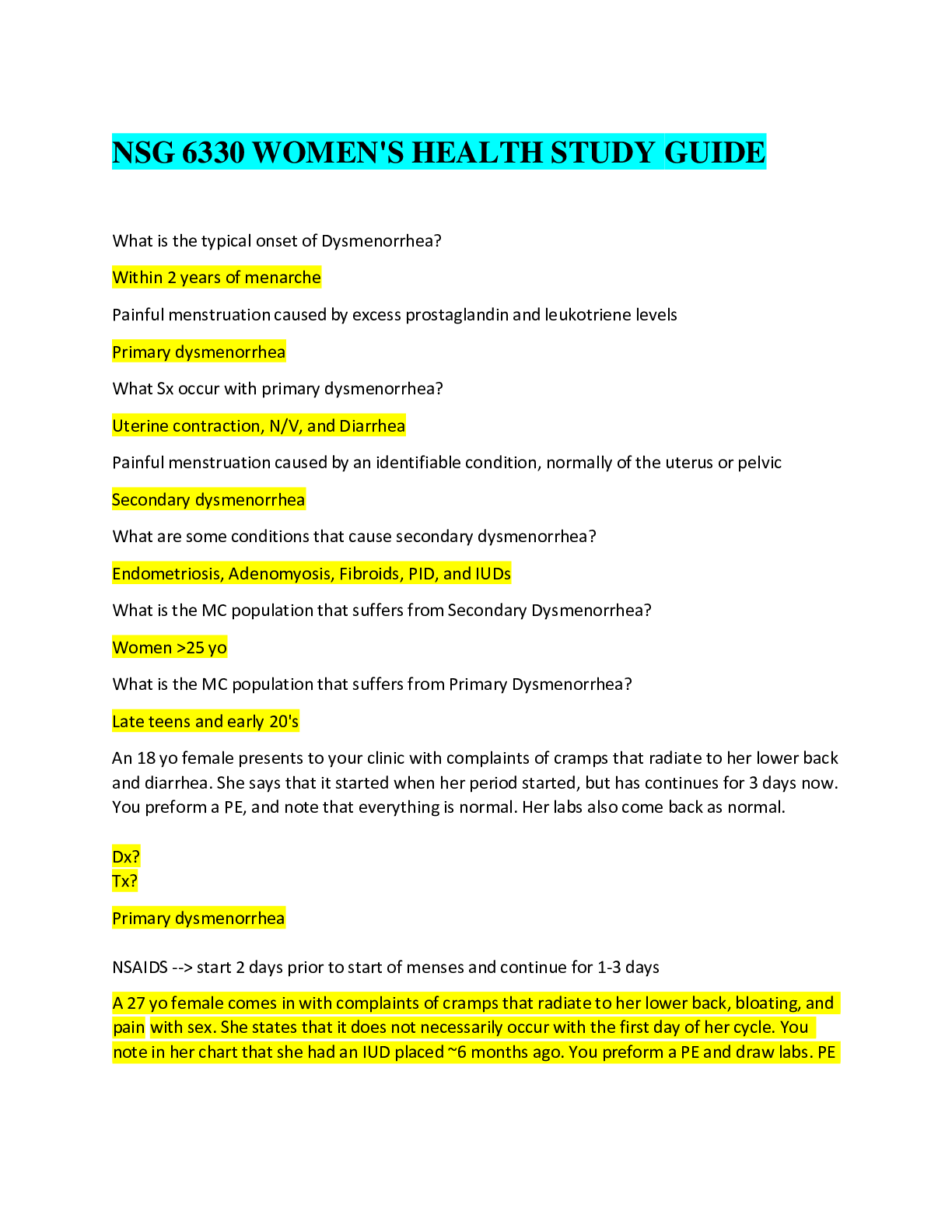Biology > STUDY GUIDE > BIO 1030 - Medications and Solutions Study Guide (All)
BIO 1030 - Medications and Solutions Study Guide
Document Content and Description Below
Medications and Solutions Role of the Perioperative Nurse The importance of knowing the patient's history cannot be overemphasized since the patient's response to preoperative and intraoperative med... ications and solutions will be potentially affected by these factors. Verifying medications The perioperative nurse is frequently the primary person responsible for verifying that the correct medication or solution, as well as the proper route and dose of the medication or solution, are administered. The perioperative nurse has a unique role, because he or she may not actually administer the medication or solution. Administration of the medication or solution may be done by another perioperative nurse, surgeon, first assistant, or scrub person; however, the perioperative nurse is responsible for a variety of activities that will be discussed shortly. Preparing medications Another unique aspect of medications and solutions administered in the OR is that many of these medications are not written as physician’s medication orders in the patient’s medical record. The perioperative nurse prepares medications and solutions from the physicians verbal order or as identified on the physician's preference card after verifying the medication, strength, and route with the physician before delivery to the sterile field and/or administration. Medication Responsibilities of the Perioperative Nurse Discussion of medications and solutions in this module is limited to those medications and solutions typically within the responsibility of the perioperative nurse. IV medications are not typically given by the perioperative nurse in the circulating role. Therefore, IV medications are not discussed in this module with the exception of conscious sedation medications. Also, medications usually administered by the anesthesia care provider are discussed in the Anesthesia Module. Specific medications and solutions will be discussed later in this module. In an effort to improve patient safety in the perioperative environment, the following precautions should be taken: Verbal orders for medication administration should be minimized. Label all medications, medication containers and other solutions on the sterile field. The perioperative nurse should write down and read back any verbal orders, per facility policy. Avoid using abbreviations that could cause medication errors. Joint Commission (JCAHO) has formulated a list of "Do Not Use" abbreviations that have been known to cause errors. Your facility may also have its own list. Please check with your policy. Obtaining patient history After the patient's identification has been verified via active communication and visually checking the identification band, the perioperative nurse obtains the patient's relevant history. Considerations include: Medication allergies and idiosyncratic responses Potential interaction with other medications Herbal or dietary supplements Patient's weight, age, and existing disease or condition Seven 'Rights' of Medication Administration 1. Right patient, i.e., properly identifying the patient before administering the medication 2. Right medication, i.e., selecting the correct medication, comparing the medication order with the medication label, assessing why the patient is being given the medication, and what the medication is expected to do 3. Right dosage, i.e., calculating the dose accurately and knowing the recommended dosage for the medication 4. Right route/method of administration, knowing the correct procedure for administering the medication via the correct route 5. Right time, i.e., administering the medication at the prescribed time 6. Right Reason, and 7. Right Documentation Guidelines for Preparing Solutions Manufacturer's recommendations: Medications and solutions should be prepared according to the manufacturer's recommendations and facility policy. Verbal verification: After the medication has been prepared, it should be verbally verified by another intraoperative team member, preferably the scrub person who will be handling the medication or solution. Verbal verification should include: Reading the label aloud stating the: Name of the medication Strength of the medication Dose to be given Medication expiration date Guidelines for Transferring Solutions The following guidelines should be noted while transferring solutions: Use of sterile technique: the medication or solution must be transferred to the sterile field using sterile technique. Do not remove stoppers from the vials for the purpose of pouring medications. Use commercially available sterile transfer devices whenever possible. Requirements for Multi-Dose Injectable Medications Multi-dose IM/IV medications should ideally be used for only one patient. If they are used for more than one patient, staff must adhere to the following guidelines: HANDLEING Multi-dose vials are dated when they are first opened and are discarded within 28 days of opening (or according to manufacturer’s recommendations; whichever date is first). DISINFECTION The rubber septum on a multi-dose vial used for more than one patient must be disinfected with alcohol before each entry. STORAGE Multi-dose medications should not be stored or accessed in the immediate areas where direct patient contact occurs. Guidelines for Labeling Solutions: All medications and solutions on and off the sterile field must be labeled with: Medication name Concentration and amount of the medication or solution if not apparent from the container Initials of the RN preparing the medication Expiration date when not used within 24 hrs Expiration time if less than 24 hrs (applies to only a few drugs) Date prepared Visual inspection is made for any indication that medications were compromised during storage (e.g., particulates, discolorization, etc.) Delivery of medications to the sterile field should include commonly available sterile transfer devices. One RN and another qualified individual should verify and double-check all medication calculations. At shift change or break relief, all medications and their labels on and off the sterile field should be noted and verified concurrently by the entering and exiting personnel Other Guidelines After the medication or solution has been administered, the perioperative nurse documents the name of the medication or solution and the dose, route, concentration, and time of administration on the intraoperative record. Equally important is documentation of the credentials (e.g., RN, CST, MD) of the preparing perioperative nurse, the scrub person handling the medication or solution, and the person administering the medication or solution. When handling medications or solutions, the perioperative nurse should keep in mind federal medication laws and regulations (e.g., the Comprehensive Medication Abuse Prevention and Control Act of 1970). Additionally, the Nurse Practice Act for your state as well as your facility policies should be considered. It is your responsibility as the perioperative nurse to be familiar with applicable laws and regulations Medications and Solutions - 1st Group The first group of medications and solutions defined includes antibiotics, anticoagulants, hemostatic agents, cardiac agents, and anti-inflammatory agents Antibiotics You might be used to thinking of antibiotics in terms of IV or IM administration. In the intraoperative setting, antibiotics are administered differently. The action of antibiotics is to prevent or control an infection Some common examples of antibiotics are: Penicillin's (e.g., ampicillin) Cephalosporins (e.g., cefazolin sodium) Aminoglycosides (e.g., neomycin sulfate, gentamycin sulfate) Sulfanomides (e.g., gantrisin) Others (e.g., bacitracin, chloramphenicol [Chloromycetin], vancomycin, tetracycline) Administration Dosages: The dosages for antibiotics depend on the antibiotic and the individual patient’s needs. Route of administration: As administered by the perioperative nurse, the typical route of administration is as a saline irrigation solution. Since antibiotics are used most often as irrigation in the intraoperative setting, your patient may receive different antibiotics in a variety of routes of administration by a variety of health care providers. Adverse reactions Allergic reactions to antibiotics are not uncommon. A reaction to Penicillin is most often seen. Among adverse reactions to penicillin are: Hypersensitivity reactions Nausea Vomiting Colitis Tissue damage (when applied topically or by irrigation) Examples Anticoagulant Examples- A common example of an anticoagulant is liquaemin (heparin). Administration Dosages: Dosages are determined, in part, by the patient's condition and operative procedure. You will need to consult the manufacturer’s recommendations and surgeon preference cards for specific dosage information. Questions need to be raised if dosage appears not to be within recommended guidelines. It is advisable that any dosage of anticoagulants be double-checked by another licensed personnel. Review your facility’s policy. Route of administration: The typical route of administration is a heparinized saline irrigation solution. Anticoagulants may be used as an irrigant. Adverse reactions Occasionally, the following hyper-sensitivities to heparin may be seen: Chills Rash Urticaria Pruritus Fever Respiratory allergic symptoms Anaphylactic/anaphylactoid reactions The reversal agent for heparin is Protamine and is typically given by the anesthesia care provider intra-operatively. Hemostatic Agents The action of hemostatic agents is to reduce capillary bleeding and assist in blood clotting by placing or spraying the hemostatic agent directly on an area. A few examples of hemostatic agents are: 1. Absorbable gelatin sponge (e.g., Gelfoam) 2. Microfibrillar collagen (e.g., Avitene) 3. Oxidized cellulose (e.g., Surgicel, Oxycel) 4. Topical thrombin Administration Dosages: Dosages are determined, in part, by the patient's condition and operative procedure. You will need to consult the manufacturer’s recommendations and surgeon preference cards for specific dosage information. Route of administration: Some agents may be placed directly on the bleeding site (topical thrombin, Gelfoam, Avitene, Surgicel, Oxycel). Topical thrombin also may be used in a spray form. Adverse reactions Hemostatic agents may generate the following adverse reactions: Topical thrombin can cause intravascular thrombosis if introduced into the vascular space. Absorbable gelatin foam use can increase risk of wound infection due to blood residue at the site. Oxidized cellulose and absorbable gelatin foam may cause pressure in confined spaces. Precautionary measures: Avoid use of hemostatic agents on pulsating arterial bleeding and in contaminated wounds. Avoid use of Microfibrillar collagen with autologous blood salvage units. Because hemostatic agents are applied topically, you may think they are relatively risk-free. Cardiac Agents The typical actions of cardiac agents used in the perioperative setting are to reduce mammary artery spasm, test patency and integrity of a graft, and sustain radial artery dilation. Examples of cardiac agents include: 1. Papaverine hydrochloride (a vasodilator used to reduce mammary artery spasm) 2. Plasma-Lyte A pH 7.4 (used to test patency and integrity of a graft) 3. Radial artery solution – A verapamil, nitroglycerin, sodium bicarbonate, heparin mixture (used to sustain radial artery dilatation) Caution: Different surgeons may use different medications in their "recipes". This one is a suggested mixture. Administration Dosages: Dosages are determined, in part, by the patient's condition and operative procedure. Papaverine and radial artery solution are diluted in normal saline. You need to consult the manufacturer's recommendations and the surgeon’s preference cards for specific dosage information. Route of administration: The following routes of administration are possible: Topical (papaverine), Irrigation (Plasma-Lyte A pH 7.4) Immersion (radial artery solution). As you can see, familiar medications and solutions can be used in unusual ways and routes. Adverse reactions Adverse reactions to cardiac agents rarely occur. However, you must be aware that precipitation will occur if Ringer’s lactate is mixed with papaverine. Anti-inflammatory Agents Some examples of anti-inflammatory agents are: 1. Dexamethasone (Decadron, Hexadrol) 2. Hydrocortisone sodium succinate (Solu-Cortef) 3. Methylprednisolone sodium succinate (Solu-Medrol) 4. Methylprednisolone acetate (Depo-Medrol) 5. Triamcinolone acetonide (Aristocort, Kenalog) The action of anti-inflammatory agents is to reduce inflammation and possible postoperative edema at operative sites. Dosages: Dosages are determined, in part, by the patient's condition and operative procedure. You need to consult manufacturer's recommendations and the surgeon’s preference cards for specific dosage information. Route of administration: Anti-inflammatory medications are administered parenterally (taken into the body in a manner other than through the digestive canal) or directly to the operative site. Adverse reactions Most adverse reactions to this group of anti-inflammatory agents are dosage- or duration-dependent. Anti-inflammatory agents play an important role in the recovery of the surgical patient. That role may start even before the operative procedure is completed, because anti-inflammatory agents may be administered intraoperatively. Avoid use of anti-inflammatory agents if a patient has shown a hypersensitivity to any component of a given anti- inflammatory. Avoid use of anti-inflammatory agents if a patient has a systemic fungal infection. Thoroughly dissolve particles in vial before administration. Medications and Solutions - 2nd Group Ophthalmic Agents: Actions Anesthetize Promote diffusion and absorption of anesthetic agent Reduce intraocular pressure Facilitate lens removal Maintain a deep anterior chamber Prevent or control infection Reduce inflammation and possibility of infection Why might it be important to reduce intraocular pressure (by giving a miotic medication) in ophthalmic surgery? It makes it easier for the surgeon to manipulate structures and minimizes tissue damage. Review proper installation technique for liquids and ointments. Include retraction of lower lid and placement of medication in the lower cul-de-sac. Examples of ophthalmic agents are: Topical anesthetic agents: Proparacaine hydrochloride, (Ophthaine), Tetracaine hydrochloride, (Pontocaine) 1. Miotic agents (used to constrict the pupil and reduce intraocular pressure): Acetylcholine chloride (Miochol), Pilocarpine, Physostigmine (Eserine) 2. Viscoelastic agent (used to maintain separation of tissues): Sodium hyaluronate (Healon or Amvisc Plus) 3. Anti-infective-steroid combination agents (used to reduce infection and/or inflammation): Dexamethasone 0.1%, Neomycin sulfate, Polymyxin B sulfate 4. Glucocorticoid agents (used to reduce inflammation): Methylprednisolone acetate suspension (Depo-Medrol), Betamethasone sodium phosphate (Celestone Phosphate), Betamethasone acetate suspension (Celestone Soluspan) 5. Enzymatic agents (used to promote diffusion and absorption of anesthetic agent), Hyaluronidase (Wydase) Dosages: Dosages are determined, in part, by the patient's condition and operative procedure. You need to consult manufacturer’s recommendations and surgeon preference cards for specific dosage information. Route of administration: The typical routes of administration are topical and by instillation. Adverse reactions Local adverse reactions include irritation, conjunctivitis, swelling, and redness. For specific adverse reactions, see the manufacturer’s insert or medication reference book Otic Agents 1. Xylocaine with epinephrine 2. Epinephrine 3. Gelfoam 4. Ringer's lactate or saline 5. Floxin Dosages: Dosages will be determined, in part, by the patient's condition and operative procedure. You need to consult manufacturer’s recommendations and surgeon preference cards for specific dosage information. Routes of administration: The routes of administration are topical or by instillation. Special consideration: Otic agents should be at body temperature before being administered to the patient. This is because, if otic agents are too cool or too hot, they may cause ear pain and exacerbate existing symptoms. Adverse reactions to otic agents include ear irritation and itching. Posterior Pituitary Hormonal Agents An example of a posterior pituitary hormonal agent is vasopressin. Dosages: Dosages will be determined, in part, by the patient's condition and operative procedure. You need to consult manufacturer’s recommendations and surgeon preference cards for specific dosage information. Route of administration: The typical route of administration is by regional injection. Adverse reactions to posterior pituitary hormonal agents include: Uterine tetany Tremor Diaphoresis Vertigo Abdominal cramps Nausea Examples Medications and Solutions - 3rd Group Irrigating Solutions Irrigating body cavities play an important diagnostic and therapeutic role in surgical procedures. Irrigating solutions are used for transurethral and gynecological procedures. The actions of irrigating solutions are: • Transurethral procedures – To flush the cavity and to ensure the patency of an irrigating system • Gynecological procedures – To irrigate, visualize, and/or distend the uterine cavity Examples Examples of transurethral resection (TUR) irrigating solutions are glycine 1.5% and other nonelectrolyte solutions. An example of gynecological irrigation solutions is Hyskon. (Dextran 70 in Dextrose solution.) Dosages: The dosages/volumes are controlled by the surgeon in most cases. Transurethral irrigation – Irrigating solutions are administered in volumes adequate to flush the cavity and to ensure irrigation system patency. Gynecological irrigation – Irrigating solutions are administered in volumes adequate to irrigate, visualize, and/or distend the uterine cavity. Route of administration: The route of administration for irrigating solutions is via an irrigation system into the bladder or the uterus. Special consideration: If a nonisotonic solution was used, it could lead to electrolyte imbalance due to solution absorption into the vascular system. Adverse reactions - Adverse reactions to irrigating solutions include: Chills Vertigo Backache Nausea Hypervolemia Other Considerations for TUR Irrigations: Do not administer if solution is cloudy. Do not administer to patients with anuria. Warm solution (not to exceed 105º F./41º C.) Maintaining strict I&O for irrigation fluids for hysteroscopy and Cystoscopy is important because excessive fluid maybe absorbed through the uterus and bladder, causing fluid overload in the patient. Diagnostic Imaging Agents The action of diagnostic imaging agents is to permit visualization of internal structures during operative procedures. Examples of diagnostic imaging agents are: 1. Renographin (used for cholangiography, sterosalpingography) 2. Cystografin (used for cystourethrography) 3. Hypaque Dosages: Dosages are determined, in part, by the patient's condition and operative procedure. The contrast media may be diluted with normal saline. You need to consult the manufacturer's recommendations and surgeon’s preference cards for specific dosage information. Route of administration: The contrast media is instilled directly into an organ or duct with a catheter or tube. The surgeon administers the contrast media. Diagnostic Imaging Agents: Adverse Effects Allergic reactions: Allergic reactions to diagnostic imaging agents are rare. If the patient has a history of possible hypersensitivity to other medical imaging procedures, report this finding. You should also identify those patients with a sensitivity to shellfish and iodine. They may be at risk for sensitization to radiographic dyes. Adverse reactions: Use of these agents in patients with multiple myeloma or paraproteinemia may cause renal failure. Use of these agents in patients with sickle cell disease may promote cell sickling. Caution: Do not use parenteral products if cloudy or discolored. Dyes Not to be confused with the previous category, Dyes provide a useful tool in facilitating the operative procedure. The purpose of dyes is to stain or mark a specific area or structure. Examples: 1. Methylene blue 2. Indigo carmine Administration: Dyes may be added to solution or may be applied directly into a structure. Marking pens may be used to mark the skin. Use of marking pens is determined, in part, by the operative procedure. You need to consult manufacturer's recommendations and surgeon’s preference cards for specific reconstitution or usage information. Medication and Solutions – 4th Group Local Anesthesia: Role of the Perioperative Nurse An operative procedure using local anesthesia gives the perioperative nurse an opportunity to use additional nursing skills. In some settings, anesthesia care providers administer local anesthesia, and in other situations the surgeon provides local anesthesia without an anesthesia care provider’s intervention. Be sure that you know your facility's policies regarding local anesthesia, especially as these policies affect the scope of your responsibilities The action of local anesthetics is to block neuromuscular conduction for a small, specific area. Role of the perioperative nurse The perioperative nurse has the ability to effectively use local anesthesia and interpret data obtained from intraoperative monitoring. When the patient is receiving local anesthesia with or without sedation, and there is no anesthesia care provider monitoring the patient, the perioperative nurse should not have circulating responsibilities. This is because the patient's status may change from local anesthesia to a conscious sedation state during the course of the procedure, and the patient would then require continuous monitoring. The usual preoperative assessment and planning is done by the perioperative nurse. Examples of local anesthesia are: • Aminoesters (2-chloroprocaine, procaine, tetracaine) • Aminoamides (lidocaine, prilocaine, mepivacaine, bupivacaine, etidocaine) Local Anesthesia: Adverse Reactions and Nursing Interventions Adverse reactions to local anesthesia includes: Symptoms of systemic toxicity include, but not limited to: Allergic reactions: Erythema Urticaria Edema Bronchoconstriction Hypotension Metallic taste Tinnitus Lightheadedness Visual disturbances Numbness of tongue and lips Confusion Tremors Shivering Generalized seizures Tachycardia/hypertension (initially) Bradycardia/hypotension (with increased toxicity) Ventricular arrhythmias; cardiac arrest Respiratory arrest Nursing intervention for adverse reactions: Intraoperative nurse intervention: Ensure patent airway Administer oxygen Provide supportive care and definitive care if needed Continuously monitor the patient's: Blood pressure Heart rate and rhythm Respiratory rate Oxygen saturation Skin color and condition Level and type of response Pain level Level of consciousness Response to medications Amount of medication administered Nursing interventions for adverse reactions Local Anesthesia: Other Considerations Other considerations for the patient include the following: Provide a calm and supportive setting for the awake patient. Have available emergency equipment and medications for interventions. Understand that the local anesthesia situation may shift to conscious sedation status as the procedure and the patient's responses evolve. Holistic comfort measures have been shown to positively affect patient outcomes Interventions may include but are not limited to: Therapeutic communication Guided imagery Music Touch Moderate Sedation The last category of medications is moderate sedation. AORN’s definition of moderate sedation is “A minimally depressed level of consciousness that allows a surgical patient to retain the ability to independently and continuously maintain a patent airway and respond appropriately to verbal commands and physical stimulation.” The action of moderate sedation is to produce a depressed level of consciousness without compromising the patient's airway or ability to respond to verbal commands. Role of the perioperative nurse As the perioperative nurse providing moderate sedation care, you use assessment skills and interventions that you might not normally use in your practice as a perioperative nurse. Within recent years, moderate sedation has come under regulatory scrutiny. For this reason and because of your professional commitment to your patients, you need to be prepared to care for patients receiving moderate sedation. ACLS certification may be required. As with local anesthesia, carefully read your facility's policies regarding moderate sedation. Additionally, it is important for you to understand your state's nurse practice act as it applies to providing moderate sedation. The perioperative nurse must have the ability to effectively use and interpret data obtained from intraoperative monitoring AND be able to operate resuscitation equipment. While caring for the patient receiving moderate sedation, the perioperative nurse does not have circulating responsibilities. Moderate Sedation: Preoperative Preparation Preoperative Assessment: Moderate sedation requires preoperative assessment which will include the usual preoperative assessment and planning by the perioperative nurse. Equipment and Supplies: • Oxygen delivery devices • Suction apparatus • Blood pressure monitoring device • Electrocardiograph • Pulse oximeter • Narcotic and sedative reversal agents Moderate Sedation: Examples and Dosages Examples of moderate sedation agents are: • Opioids (morphine sulfate, meperidine hydrochloride, fentanyl) • Benzodiazepines (diazepam, midazolam) Dosages: Dosages will be determined, in part, by the patient's condition, response to medications, and operative procedure. You need to consult manufacturer's recommendations, surgeon preference cards, and your facility's policy for dosage information. Route of administration: IV administration is the typical route of administration for these medications Moderate Sedation: Adverse Reactions and Nursing Interventions Adverse reactions to moderate sedation agents include: Respiratory depression (opiods) Venous thrombosis, phlebitis, local irritation, drowsiness, confusion Adverse effects of Propofol: There is much controversy surrounding the use of nurse-administered propofol (Diprivan). The controversy stems from the fact that with propofol there is the potential for a deeper level of anesthesia. Nurse administered propofol is contrary to manufacturers recommendations. Propofol is a short acting anesthetic agent used in general anesthesia and sedation procedures. It is used extensively in gastroenterology procedures, where nurses often monitor conscious sedation. There is no reversal agent for propofol. Please check with your State Board of Nursing and facility's policies on nurse-administered propofol Nursing interventions for adverse reactions: Ensure patent airway. Administer oxygen. Provide supportive care. Provide definitive care (including administering a reversal agent). Administer a reversal agent (Naloxone hydrochloride (Narcan) – used for opioids, Flumazenil (Romazicon) – used for benzodiazepines) Continuously monitor the patient's: Blood pressure Heart rate and rhythm Respiratory rate Oxygen saturation Skin color and condition Level and type of response Response to pain Amount of medication used and their effects Moderate Sedation: Other Considerations Provide a calm and supportive setting for the sedated patient. Prepare emergency equipment and medications for interventions. Understand that the consciously sedated patient's status may require cardiopulmonary support as the procedure and the patient's responses evolve. Moderate Sedation: Documentation Accurate recording of interventions and observations is as important as the interventions and observations themselves. The documentation record will vary from facility to facility, as will the frequency of interventions (e.g., vital signs). If you provide moderate sedation for your patient, it is essential that another perioperative nurse function in the circulating role. It is also vital that you are prepared to provide the necessary nursing interventions. This preparation may require additional training. Check with your facility's policies regarding conscious sedation and your qualifications to provide this level of care. Medications and Solutions - Module Summary The accurate administration of medications and solutions is essential for safe patient care and for the promotion of patient healing. The perioperative nurse is frequently the primary person responsible for verifying that the correct medication or solution, as well as the proper route and dose of the medication or solution, are administered. For all medications and solutions, it is essential to follow the five 'rights' of medication administration: the right patient, the right medication, the right dosage, the right method of administration, and the right time. The first group of medications and solutions studied included antibiotics, anticoagulants, hemostatic agents, cardiac agents, and antiinflammatory agents. The action of antibiotics is to prevent and control infection. The action of anti-coagulants is to prevent or prolong the coagulation of blood. The action of hemostatic agents is to reduce capillary bleeding and assist in blood clotting. In the perioperative setting, cardiac agents act to reduce mammary artery spasm, test patency and integrity of a graft, and sustain radial artery dilation. Anti-inflammatory agents are used to reduce inflammation and possible postoperative edema at operative sites. The second group of medications and solutions studied included ophthalmic agents, otic agents, and posterior pituitary hormonal agents. Ophthalmic agents have many actions including anesthetic action, reduction of intraocular pressure, facilitating lens removal, and preventing or controlling infection and inflammation. Ophthalmic agents include topical anesthetic agents, miotic agents, viscoelastic agents, anti-infective-steroid combination agents, glucocorticoid agents, and enzymatic agents. Otic agents are used in ear surgery to anesthetize, stop or slow bleeding, and for irrigation. Posterior pituitary hormonal agents act to stimulate the uterine muscle. The third group of medications and solutions studied included irrigating solutions, diagnostic imaging agents (radiopaque media), and dyes. Irrigating solutions are used to flush, visualize, and/or distend cavities (especially the uterine cavity), and ensure the patency of an irrigating system. Radiopaque media are used to permit visualization of internal structures during operative procedures. The final group of medications and solutions studied included local anesthetic agents and moderate sedation agents. Local anesthetics are used to block neuromuscular conduction for a small, specific area. Moderate sedation produces a depressed level of consciousness without compromising the patient's airway or ability to respond to verbal commands. [Show More]
Last updated: 2 years ago
Preview 1 out of 21 pages

Buy this document to get the full access instantly
Instant Download Access after purchase
Buy NowInstant download
We Accept:

Reviews( 0 )
$13.50
Can't find what you want? Try our AI powered Search
Document information
Connected school, study & course
About the document
Uploaded On
Dec 16, 2020
Number of pages
21
Written in
Additional information
This document has been written for:
Uploaded
Dec 16, 2020
Downloads
0
Views
95
